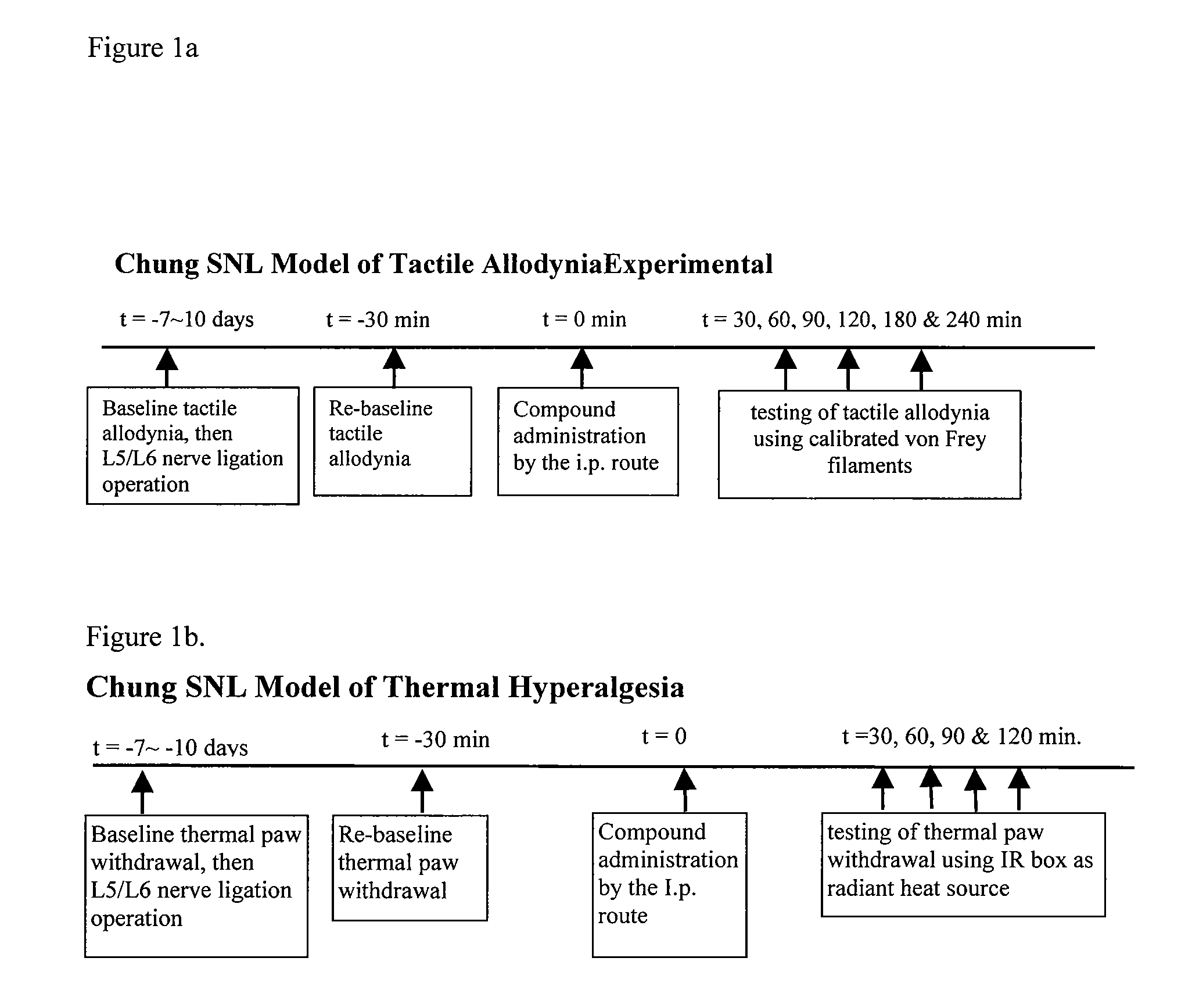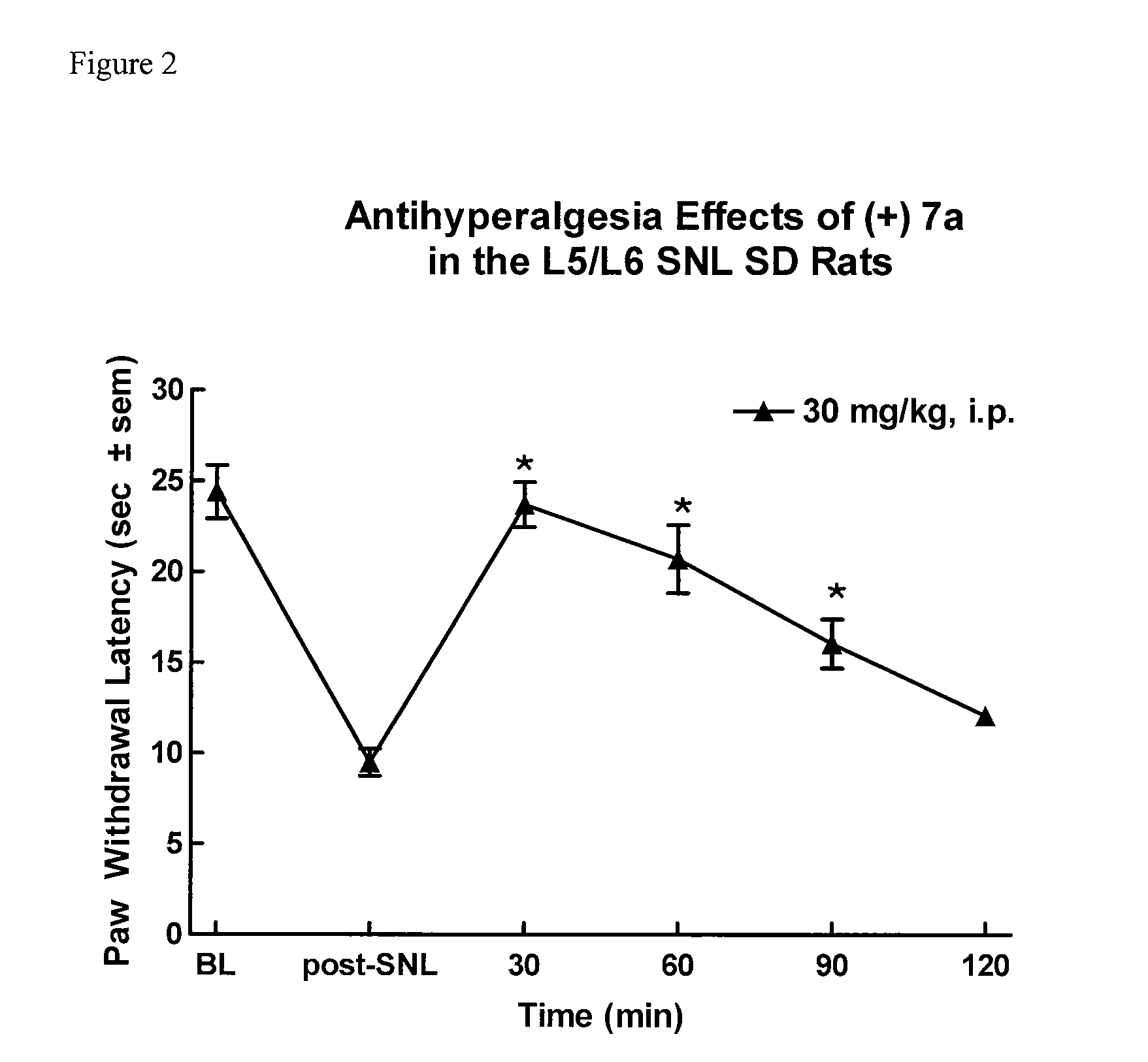3,5 - substituted indole compounds having nos and norepinephrine reuptake inhibitory activity
a technology of indole and inhibitory activity, which is applied in the field of new drugs, can solve the problems of many barriers to the development of new drugs, poor treatment effect, and inability to provide new drugs for pain management, so as to prevent the spread of disease, delay or slow the progress of disease, and reduce the extent of disease
- Summary
- Abstract
- Description
- Claims
- Application Information
AI Technical Summary
Benefits of technology
Problems solved by technology
Method used
Image
Examples
example 1
Preparation of dihydrochloride salt of N-(3-(4-(methylamino)cyclohexyl)-1H-indol-5-yl)thiophene-2-carboximidamide (Compound 1):
[0145]
[0146]This compound was prepared as described in U.S. Pat. No. 7,375,219, herein incorporated by reference.
[0147]5-Nitro-3-(1,4-dioxaspiro[4.5]dec-7-en-8yl)-1H-indole: A solution of 5-nitroindole (0.2 g, 1.233 mmol) in dry MeOH (5 mL) was treated with KOH (0.56 g) at room temperature. After stirring for 10 min., 1,4-cyclohexanedione monoethylene acetal (0.48 g, 3.083 mmol) was added, and the resulting solution was refluxed for 36 h. The reaction was brought to room temperature, and solvent was evaporated. Crude was diluted with water (25 mL), and product was extracted into ethyl acetate (2×25 mL). The combined ethyl acetate layer was washed with brine (20 mL) and dried (Na2SO4). Solvent was evaporated and crude was purified by flash-column chromatography (EtOAc) to obtain the title compound (0.25 g, 68%) as a solid. mp 175-177° C.; 1H NMR (CDCl3) δ 1.9...
example 2
Separation of cis and trans N-(3-(4-(methylamino)cyclohexyl)-1H-indol-5-yl)thiophene-2-carboximidamide (1a and 1b):
[0154]
[0155]N-(3-(4-(Methylamino)cyclohexyl)-1H-indol-5-yl)thiophene-2-carboximidamide (1a & 1b): Compounds 1a and 1b were separated from compound 1 using normal phase semi-preparative column chromatography using HPLC (EtOAc: Et2NH in MeOH, 95:5 to 4:1, Zorbax normal phase, silica column, Injection volume: 100 μL, 100 mg / 0.5 mL concentration, flow rate: 4 mL / min.). Compound 1a (first eluting product; cis-isomer, non-polar isomer): 1H NMR (DMSO-d6) δ 0.81-0.91 (m, 1H), 0.94-1.01 (m, 1H), 1.08-1.13 (m, 1H), 1.53-1.96 (m, 6H), 2.27 (s, 3H), 2.59-2.64 (m, 1H), 2.73-2.80 (m, 1H), 6.18 (brs, 2H), 6.61 (d, 1H, J=8.4 Hz), 6.96-7.00 (m, 2H), 7.09 (dd, 1H, J=3.9, 5.1 Hz), 7.25 (d, 1H, J=8.4 Hz), 7.58 (d, 1H, J=5.4 Hz), 7.70 (d, 1H, J=2.7 Hz), 10.52 (s, 1H); ESI-MS (m / z, %) 353 (MH+ for free base, 30), 322 (100), 119 (51); ESI-HRMS calculated for C20H25N4S (MH+ for free base), Cal...
example 3
Preparation of N-(3-(4-(dimethylamino)cyclohex-1-enyl)-1H-indol-5-yl)thiophene-2-carboximidamide (compound (±)−2):
[0157]
[0158]4-(5-Nitro-1H-indol-3-yl)cyclohex-3-enone: For complete experimental details and spectral data, see example 1.
[0159]N,N-Dimethyl-4-(5-nitro-1H-indol-3-yl)cyclohex-3-enamine: A solution of 4-(5-nitro-1H-indol-3-yl)cyclohex-3-enone (1.0 g, 3.902 mmol) in dry 1,2-dichloroethane (10 mL) was treated with N,N-dimethyl amine hydrochloride (0.31 g, 3.902 mmol), AcOH (0.22 mL, 3.902 mmol), NaBH(OAc)3 (1.24 g, 5.853 mmol) at room temperature, and the resulting mixture was stirred overnight (14 h). The reaction was diluted with 1 N NaOH (30 mL), and product was extracted into ethyl acetate (2×50 mL). The combined ethyl acetate layer was washed with brine (20 mL) and dried (Na2SO4). Solvent was evaporated, and crude was purified by column chromatography (2 M NH3 in MeOH: CH2Cl2, 1:9) to obtain the title compound (0.73 g, 66%) as a brown solid. mp 234-236° C.; 1H NMR (DMS...
PUM
| Property | Measurement | Unit |
|---|---|---|
| temperatures | aaaaa | aaaaa |
| concentration | aaaaa | aaaaa |
| concentration | aaaaa | aaaaa |
Abstract
Description
Claims
Application Information
 Login to View More
Login to View More - R&D
- Intellectual Property
- Life Sciences
- Materials
- Tech Scout
- Unparalleled Data Quality
- Higher Quality Content
- 60% Fewer Hallucinations
Browse by: Latest US Patents, China's latest patents, Technical Efficacy Thesaurus, Application Domain, Technology Topic, Popular Technical Reports.
© 2025 PatSnap. All rights reserved.Legal|Privacy policy|Modern Slavery Act Transparency Statement|Sitemap|About US| Contact US: help@patsnap.com



